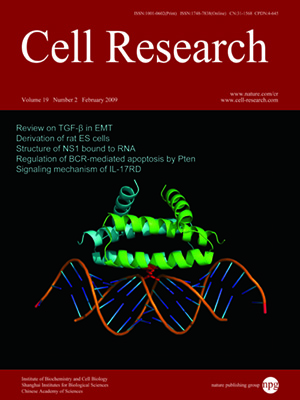
Volume 19, No 2, Feb 2009
ISSN: 1001-0602
EISSN: 1748-7838 2018
impact factor 17.848*
(Clarivate Analytics, 2019)
Volume 19 Issue 2, February 2009: 259-267
ORIGINAL ARTICLES
Functional characterization of the human-specific (type II) form of kallikrein 8, a gene involved in learning and memory
Zhi-xiang Lu1,2,4, Qin Huang3,4 and Bing Su1,2
1State Key Laboratory of Genetic Resources and Evolution, Kunming Institute of Zoology, Chinese Academy of Sciences, Kunming 650223, China
2Kunming Primate Research Center, Chinese Academy of Sciences, Kunming 650223, China
3Institute of Biochemistry and Cell Biology, Shanghai Institutes for Biological Sciences, Chinese Academy of Sciences, Shanghai 200031, China
4Graduate School of Chinese Academy of Sciences, Beijing 100049, China
Correspondence: Bing Su,(sub@mail.kiz.ac.cn )
Kallikrein 8 (KLK8) is a serine protease functioning in the central nervous system, and essential in many aspects of neuronal activities. Sequence comparison and gene expression analysis among diverse primate species identified a human-specific splice form of KLK8 (type II) with preferential expression in the human brain, which may contribute to the origin of human cognition. To gain insights into the physiological and biochemical role of this novel form, we conducted functional analyses of human type II KLK8. Our results show that type II KLK8 is abundantly expressed in human embryonic stem cells and in embryo brain samples, suggesting a potential role in embryogenesis. There are dramatic expression variations in different individuals and brain regions, which is a reflection of its dynamic role in neural activities. Furthermore, the transcription start site (TSS) of KLK8 is tissue-specific, with a brain-specific TSS found in humans indicating functional specialization. Our in vitro biochemical assay shows that there is a type II-specific intermediate protein form, although the processed end-point enzymes are the same for both type I and type II KLK8, suggesting that the emergence of type II KLK8 in the human brain likely leads to functional modifications of KLK8.
Cell Research (2009) 19:259-267. doi: 10.1038/cr.2009.4; published online 6 January 2009
FULL TEXT | PDF
Browse 1891


